BABI - YAR - I
(Please, observe the credits at the bottom or in the page of credits)
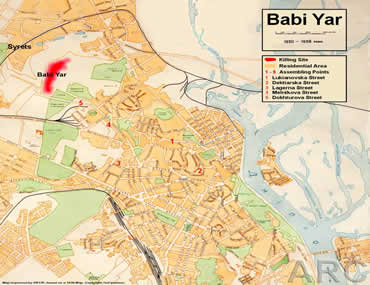 |
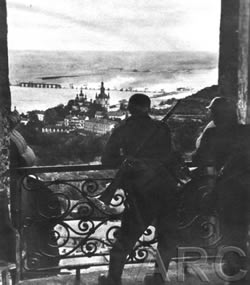 |
1930
Map |
Kiev,
Setember 1941 |
On 19/20 September
1941 Kyiv (Kiew) was occupied by the XXIXth German Army Corps and the 6th Army.
875,000 people lived in the city, of whom 20% were Jews (175,000). Some factories
important for military purposes and their workers, among them approximately
20,000-30,000 Jews were evacuated by the Soviets. The exact number of evacuated
Jews is unknown since no count was taken at that time. Perhaps 130,000 Jews
fell into Nazi hands. Any ordinary citizen had great difficulty in leaving the
city because of transportation restrictions.
The population remembered the last German occupation in 1918 and were convinced
that the occupiers would act as expected: in a civilized manner... It was anticipated
that the Germans would restore the rights and property of the populace abolished
by the Soviets. The citizens of Kiev were not aware of the risks involved in
falling into German hands, and could not imagine their ultimate fate.
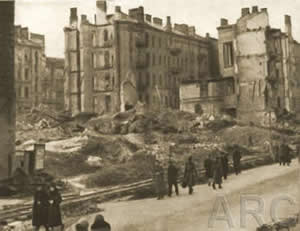 |
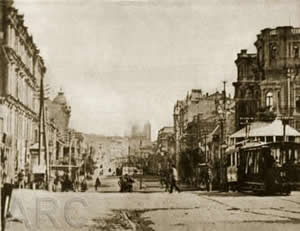 |
Kreshchatik
Street Ruins |
Kreshchatik
Street |
Jews had already
been persecuted and killed during the first days of the occupation. However,
for reasons still unknown, a ghetto was not established in Kyiv.
On 24 September 1941, and in the following days, several bombs were detonated
in Kyiv (Kreshchatik and Prorizna Streets), and destroyed some occupied buildings
in the centre of the town, including the army headquarters and the Hotel Continental,
where German officers resided. Hundreds of German soldiers and officers were
killed. The resulting fire also destroyed some further buildings. These bombs
had been placed by a special command of NKVD agents who intentionally remained
in Kyiv for this purpose.
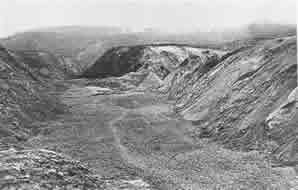 |
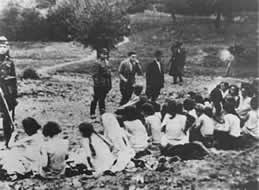 |
Babi
Yar in 1943 |
Group
of women waiting their time to be murdered |
Wehrmachtsgeneral
Alfred Jodl testified at his trial in Nürnberg:
"... hardly had we occupied the city when one tremendous explosion after
another occurred. The major part of the inner city burned down, 50,000 people
were made homeless. German soldiers were used to fight the flames, and suffered
considerable losses, because further large amounts of explosives detonated during
the fire...
At first, the local commander in Kyiv thought that it was sabotage on the part
of the population, but then we found a demolition chart, which had already been
prepared a long time ago, listing 50 or 60 objectives in Kyiv for destruction.
This chart was, in fact, correct, as investigation by engineers at once proved.
At least 40 more objectives were ready to be blown up; for the most part, remote
control was to set off the explosion by means of radio waves. I myself had the
original of this demolition chart in my hands."
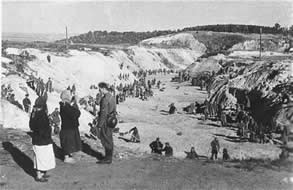 |
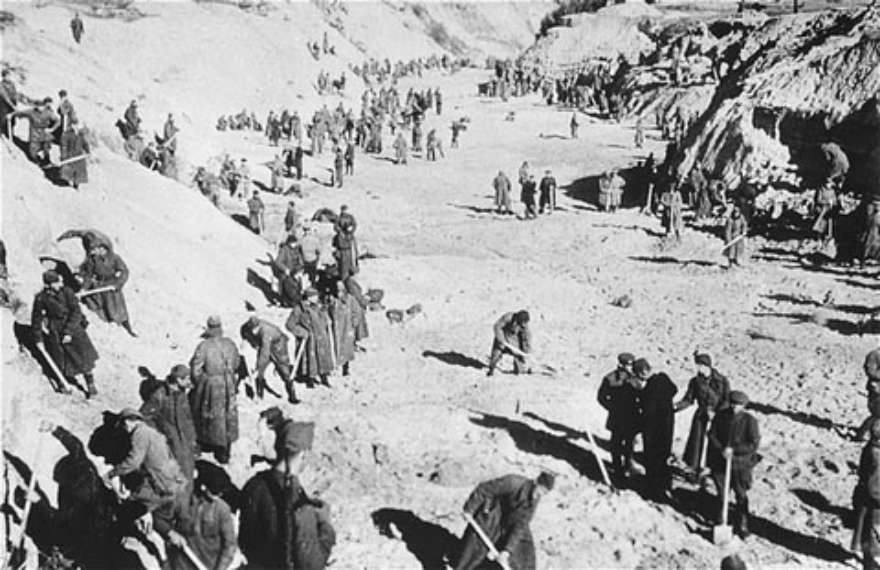 |
According
to the interrogation protocol of the former POW B. V. Sokolov he confirmed
that in October 1941 about 300 POWs were taken to the ravine to bury the
bodies. In the photo they level the earth over the mass graves. The German
soldier (foreground) is showing Ukrainian women the workers in the ravine. |
In
the photo the POWs (prisoners of war) level the earth over the mass graves,
guarded by German soldiers (foreground and upper left). |
German troops caught
and executed a Jew on Kreshchatik Street, when he cut a water hose that was
being used for fighting the fire. That may have been the excuse the Germans
needed to accuse the Kyiv Jews of being responsible for the explosions. The
German military commander of Kyiv, Generalmajor Eberhardt, attended a meeting
with the Höherer SS- und Polizeiführer SS-Obergruppenführer Friedrich
Jeckeln, the commanding officer of Einsatzgruppe C, SS-Brigadeführer Dr
Otto Rasch, and the commanding officer of Sonderkommando 4a, SS-Standartenführer
Paul Blobel. They decided that the appropriate response to this sabotage should
be the elimination of all Kyiv Jews, carried out by Sonderkommando 4a, consisting
of SD and Sipo members, the 3rd company of the Waffen-SS Batallion zur besonderen
Verfügung, and a platoon of the 9. Polizeibatallion. In addition Police
Battalions 45 and 305 of the Polizeiregiment Süd and some Ukrainian auxiliary
police troops would reinforce this murder squad.
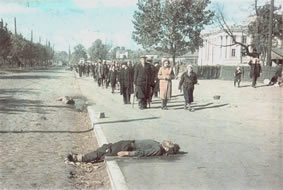 |
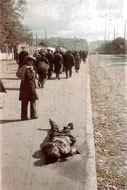 |
Murdered
men on the edges of the sidewalks. Location: the right side of Pobeda
("Victory") Avenue. Ukrainian passers-by are going to "Yevbaz"
(Yevreyskiy / Jevrejskiz (Jewish) bazaar (market). |
Ukrainian
passers-by are going to "Yevbaz". Location: the right side of
Pobeda ("Victory") Avenue. After the occupation the markets
were the only place where people could buy or exchange their things for
food. People went by foot because trams were not operating, and only Germans
had cars. |
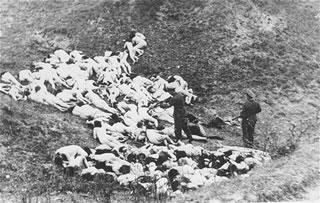 |
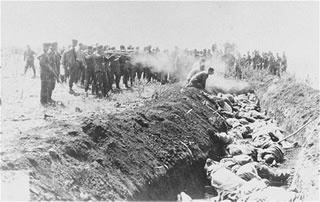 |
After
a mass execution of Jews in the ravine, a German policeman shoots a Jewish
women who remains alive and is trying to stand up .
|
Soldiers
in the act of shooting Jewish civilians into a pit. |
A large ravine,
called Babi Yar (Babi Jar / Ukr.: Babyn Jar), was chosen as the killing site.
This ravine was located at the edge of Kyiv, around 10 km northwest of the centre
of the city. Today it lies within the city precincts.
On 28 September 1941 the German 637th propaganda company issued an announcement
throughout Kyiv, published by the printing office of the 6th Army, ordering
the Jews to assemble the next day (Monday, the 29th / Yom Kippur, at 8 a.m.)
at Lukianovska, Degtiarska, Lagerna, and Melnikova Streets:
"All Jews
living in the city of Kiew and its vicinity must come to the corner of Melnikova
and Dokhturova Streets (near the cemeteries) by 8 o'clock on the morning of
Monday, September 29th 1941.
They are to bring with them documents, money, valuables, as well as warm clothes,
underwear etc. Any Jews not carrying out this instruction and who are found
elsewhere will be shot. Any civilian entering apartments left by the Jews and
stealing property will be shot."
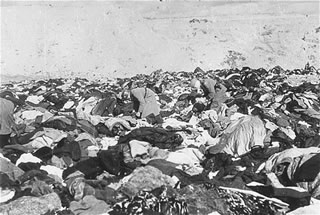 |
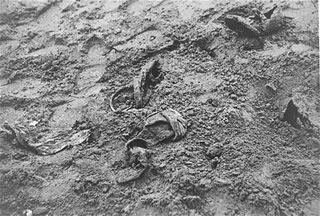 |
German
police look through the clothing of people killed at Babi Yar.
|
The
remains of shoes and clothing of people killed in the ravine at Babi Yar.
|
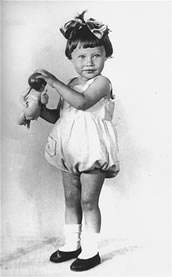 |
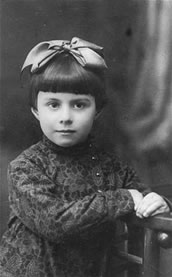 |
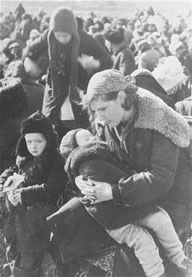 |
Portrait
of two-year-old Mania Halef, a Jewish child, who was later killed during
the mass execution at Babi Yar. |
Portrait
of three-year-old Anna Glinberg, a Jewish child who was later killed during
the mass execution at Babi Yar. |
Close-up
of a young mother with her two children who have been assembled for mass
execution by the Germans. |
Thousands of Jews
followed this order. In addition, to reinforce the propaganda, the Germans spread
rumours that the Jews would be resettled to labour camps. Since the assembling
point was situated near the goods station Lukianivka, most Jews believed the
rumours.
Guarded by SS, SD and Ukrainian auxiliaries, the Jews were marched in groups
of 100 via the Melnikova Street to the Jewish cemetery located near the ravine
called "Babi Yar". The entire surroundings of the ravine had been
fenced in with barbed wire, and were cordoned off by three rows of troops: The
outer circle was manned by Ukrainian police, the second with Ukrainian police
and Germans, and the inner circle with Germans only.
At the killing site the Jews were ordered to undress, stack their belongings,
and were then led in shot." groups of 10 to the edge of the ravine. There
they were shot (by automatic guns and machine-guns) in front of their fellow
sufferers, who were unable to escape.
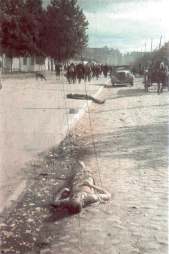 |
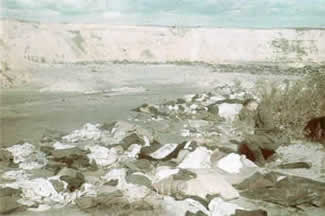 |
The
murdered men are probably Jews who did not arrive on 29 September at the
designated place, as ordered, and were shot. Location: the right side
of Pobeda ("Victory") Avenue. After having taken these photos
Hoele went to Babi Yar. |
When
Hoele came to Babi Yar he entered the ravine, and was overwhelmed by the
huge quantities of belongings of the murdered Jews. He seized the opportunity,
and took some photos of the possessions of the victims. |
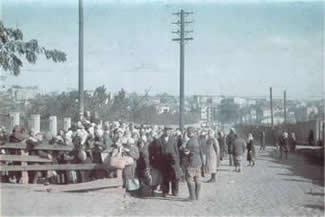 |
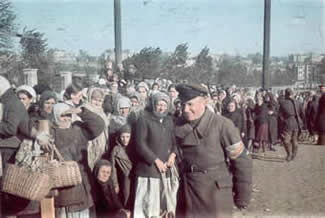 |
This
photo was taken at the corner of Kerosinnaja and Lagernaja Streets, near
the "Zenit" Stadium. Ukrainan women (in all probability) tried
to learn about the fate of their relatives, who possibly resided in nearby
barracks. |
This
photo was taken at the corner of Kerosinnaja and Lagernaja Streets, near
the "Zenit" Stadium. Ukrainan women (in all probability) tried
to learn about the fate of their relatives, who possibly resided in nearby
barracks. |
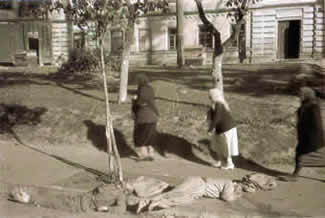 |
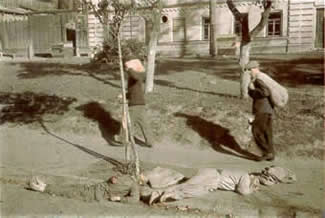 |
This
photo was taken not far from Yevbaz. The murdered men are probably POWs,
judging by their haircut and their exhausted frames. |
Inhabitants
of Kiev passed the corpses. |
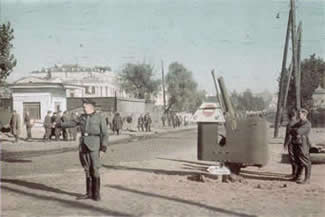 |
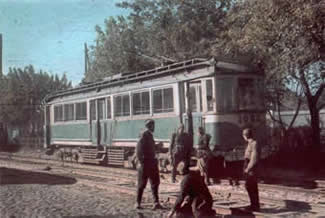 |
Blocked
road. Traffic control. |
POWs
busy with repair works, and a German escort. |
The witness Iryna
Khoroshunova, resident of Kiev, stated in her diary entry for 29 September 1941:
"We still don't know what they did to the Jews. There are terrifying rumours
coming from the Lukianivka Cemetery. But they are impossible to believe. They
say the Jews are being shot... Some people say the Jews are being shot with
machine guns, all of them. Others say that 16 train wagons have been prepared
and that they will be sent away. Where to? Nobody knows. Only one thing seems
clear: all their documents, things, and food are confiscated. Then they are
chased into Babi Yar and there... I don't know. I only know one thing: there
is something terrible, horrible going on, something inconceivable, which cannot
be understood, grasped or explained."
By 2 October all doubts had disappeared:
"Everybody is saying now that the Jews are being murdered. No, they have
been murdered already. All of them, without exception - old people, women and
children. Those who went home on Monday (29 September) have also been shot.
People say it in a way that does not leave any doubt. No trains left Lukianivka
at all. People saw cars with warm shawls and other things driving away from
the cemetery. German "accuracy". They already sorted the loot!
A Russian girl accompanied her girlfriend to the cemetery, but crawled through
the fence from the other side. She saw how naked people were taken toward Babi
Yar and heard shots from a machine gun. There are more and more rumours and
accounts. They are too monstrous to believe. But we are forced to believe them,
for the shooting of the Jews is a fact. A fact which is starting to drive us
insane. It is impossible to live with this knowledge. The women around us are
crying. And we? We also cried on 29 September, when we thought they were taken
to a concentration camp. But now? Can we really cry? I am writing, but my hair
is standing on end."
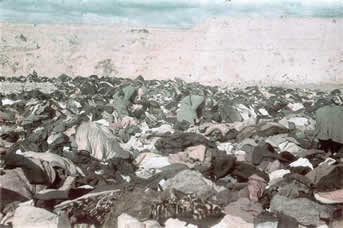 |
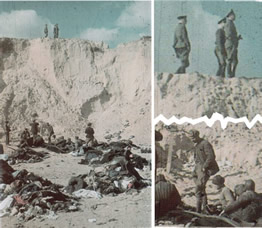 |
Possessions
of the victims. German soldiers are searching the clothes for valuables. |
POWs
in the ravine. They are members of former Soviet elite units, judging
by the clothes. The Germans needed physically fit men for this task. |
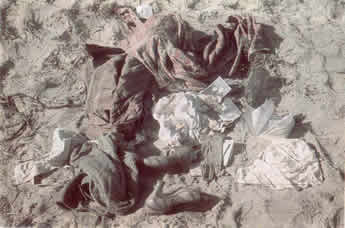 |
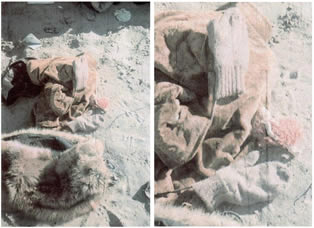 |
Possessions
of the victims: Clothes, a pair of shoes, and two photos. |
A
child's jacket with mittens. They are connected with a string to avoid
loosing them. |
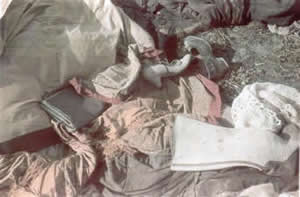 |
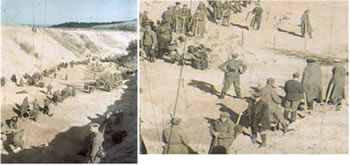 |
Possessions
of the victims. |
In
early October 1941 about 300 POWs were taken to the ravine to bury the
bodies. In the photo approximately 150 of them level the earth over the
mass graves, guarded by German soldiers. |
More people than
expected were brought to the site. According to a report from Einsatzgruppe
C:
"...originally we estimated the arrival of only 5,000-6,000 Jews, but actually
about 30,000 Jews presented themselves, believing until the moment of liquidation
that they would be resettled, because of the great work of the propaganda section."
As a result the Germans could not kill all of the Jews immediately. The historian
Felix Levitas wrote:
"The executioners did not have enough time to finish their job. Therefore
they began to put two people together, head by head, so that one bullet would
kill two people. The wounded people were killed with shovels. The children were
thrown into the Yar alive and buried with them."
Sergey Ivanovich Lutsenko, former guard of the Lukianivka cemetery, testified:
"They shot people from morning to night. At night the Germans went to sleep.
The rest of the victims were locked in empty garages. This continued for five
days. The Nazis brought more and more people, and from there only trucks with
people's clothes returned."
More testimonies.
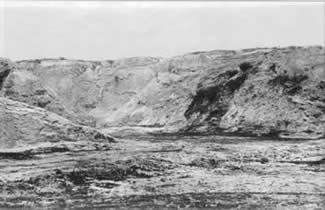 |
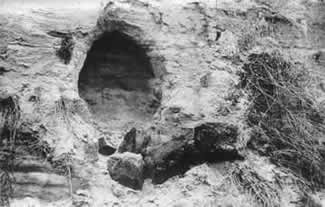 |
The
place where bodies were burned. |
Remains
of the pyres, and the dug-out in Babi Yar where the inmates housed. |
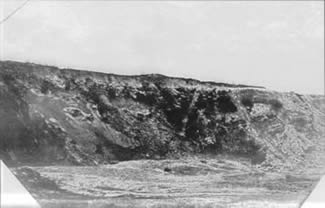 |
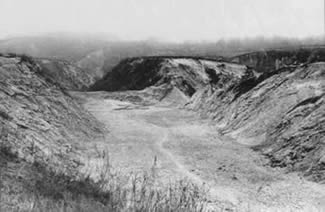 |
The
place in Babi Yar where the bodies were burned. |
The
place of shootings in Babi Yar. |
The mass murder
of Kyiv Jews lasted until 3 October 1941. During the following months the ravine
continued to be used as a killing site for Jews, Ukrainian civilians, Soviet
POWs and Roma and Sinti. According to Soviet sources 100,000-200,000 people
were shot at Babi Yar up until the time that the area was liberated by the Red
Army on 6 November 1943. According to the "Operations Situation Report
of Einsatzgruppe C" of 7 October 1941, the Germans claimed that 33,771
Jews had been shot in 1941.
Some Ukrainian inhabitants denounced their Jewish neighbours, others offered
hiding places. After the war the Sipo and SD chief stated that his office in
Kyiv received baskets-full of denunciations from Ukrainian citizens. His office
had insufficient time to deal with all of this information.
Since 1990 the Jewish Board of the Ukraine has given the title "Righteous
of Babi Yar" to 431 gentiles who hid Jews and thereby saved them from being
killed by the Nazis. This title was bestowed on all family members alive at
the time of the executions because all members of a family would have been shot
by the Germans if their aid had been discovered.
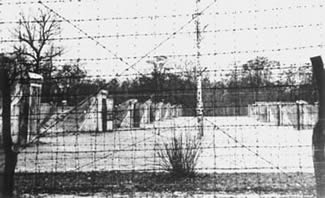 |
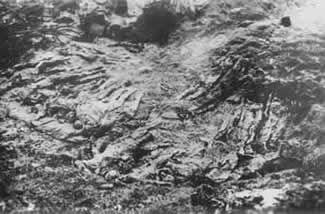 |
The
Syretskij concentration camp. It was located nearby the ravine. |
The
Syretskij concentration camp. The corpses were dug out of a trash pit |
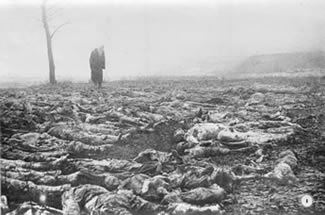 |
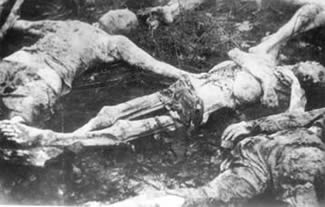 |
The
Syretskij concentration camp. The corpses dug out of trash pit. |
The
Syretskij concentration camp. The bodies were dug out of pits. |
When the German
troops retreated from Kyiv in 1943, it was determined that all remaining inhabitants
should be sent to Germany. Witness Kuznetsov stated:
"... The troops began the roundup on the outskirts of the city, driving
everyone out into the streets - those who could walk and those who couldn't
- prodding them with rifle butts, with blows or by firing in the air. People
were given only a few minutes to prepare. They were told that Kyiv was to be
evacuated to Germany; there would be no such city anymore.
It was dismayingly reminiscent of the procession of Jews in 1941. Masses of
people were on the move, including wailing children, the aged and sick."
Nikita Khruschev on 8 November 1943:
"The Germans attempted to drive away the entire population of the city.
They rounded up the inhabitants with dogs specially trained for hunting people...
The Germans committed a mass murder of those people that hid to avoid being
sent to Germany... They succeeded in driving out a significant majority of the
population. Kyiv gives the impression of an extinct city."
In July 1943 Blobel came back to Kyiv. Because of the approaching Red Army he
was ordered to remove all traces of mass murder in the East. In the Kyiv area
his units were assisted by SS-Gruppenführer Max Thomas, commander of the
SD and Sipo in the Ukraine.
Blobel established three special units from his Aktion 1005 troops: Sonderkommando
1005 A and 1005 B in the Ukraine, and Sonderkommando 1005 Mitte for the Minsk
area.
Around 18 August the Sonderkommando 1005 A started to exhume and burn the corpses.
This Sonderkommando consisted of 8-10 SD men and 30 German policemen, commanded
by SS-Obersturmbannführer Baumann. Of course the Germans did not carry
out this work themselves. 327 inmates of the KZ Syrets (among them 100 Jews)
were forced to undertake this horrible task. The prisoners completed this work
within six weeks. Those sick or too slow were shot on the spot. A German Schupo
witness:
"Every prisoner was shackled on both legs with a 2-4 metre long chain...
The piles of corpses were not set on fire at regular intervals, but whenever
one or more piles were ready, they were covered with wood and soaked with oil
and gasoline and then ignited."
Blobel, on 18 June
1947:
"During my visit in August I myself witnessed the burning of corpses in
a mass grave near Kiew. This grave was approximately 55 metres long, 3 metres
wide and 2.5 metres deep. After the cover had been removed, the corpses were
covered with inflammable materials and set on fire. About two days passed before
the fire had burned down to the bottom of the trench. Afterwards the grave was
filled in and all traces thereby virtually obliterated. Because of the advance
of the front it was not possible to destroy the mass graves located in the South
and East which had resulted from execution by the task groups."
The corpses were cremated on funeral pyres, built on iron rails. Firewood was
stacked, then the corpses were placed on this petrol soaked material. When the
pyres had burned down, the special command of prisoners had to collect the remaining
bones which were pulverized with tombstones from the Jewish cemetery. Finally
the ashes were inspected in order to collect any remaining silver and gold (these
men were called "Goldsucher" ("Gold diggers").
On 29 September 15 prisoners of the Sonderkommando were able to escape; 312
of their comrades were finally killed by the SS either during or on completion
of the work. In October 1944 the remaining troops of Aktion 1005 were ordered
to Kärnten (Carinthia / Austria) to fight against Yugoslav partisans, under
the name "Einsatzgruppe Iltis", commanded by Blobel.
For political reasons an official memorial was not built at the site until 1976.
The first memorial did not mention that most victims were Jews. It took a further
15 years before a new memorial (Menorah) was built which today serves as a place
for commemorative ceremonies.
The most impressive memorial, a symbolic one, is Yevgeny Yevtushenko's poem
'Babi Yar'. This work of art was published in 1961. Dmitri Shostakovich used
the poem as part of his 13th Symphony, a powerful piece of music that caused
a sensation when premiered in 1962.
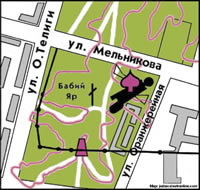 |
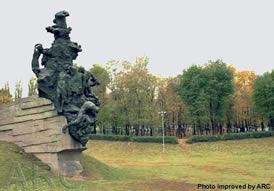 |
Babi
Yar Memorial Map |
Babi
Yar today |
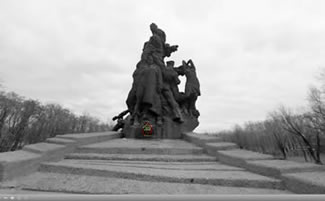 |
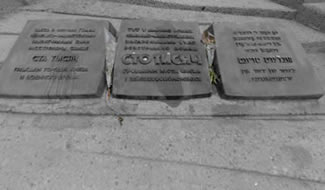 |
Babi
Yar today |
Babi
Yar today |
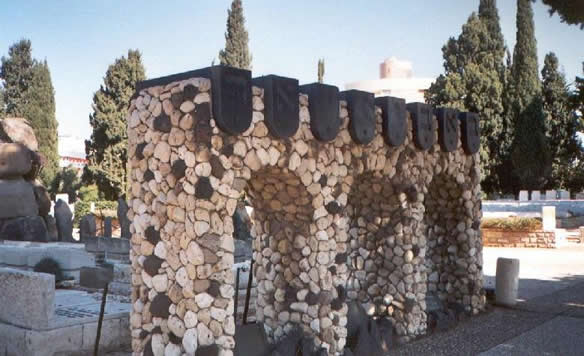 |
The
memorial monument of Babi Yar in Nachlat Itzhak cemetery, Givataiim, Israel |
Sources:
Khiterer, Victoria.
Babi Yar, the Tragedy of Kiev's Jews
Gutman, Israel, ed. Encyclopedia of the Holocaust, Macmillan Publishing Company,
New York, 1990
Ernst Klee. Willi Dreßen. "Gott mit uns" - Der deutsche Vernichtungskrieg
im Osten 1939-1945, S. Fischer Verlag, Frankfurt am Main 1989
Sergey Romanov
Observations:
In this page we show photos which testify the mass murder at Babi Yar. Some
of the photos were taken by Johannes Hoele, a military photographer with the
German Propaganda-Kompanie 637 of the 6th Army. He took the photos most probably
on 1 October 1941. Hoele died in 1944.
All his photos are from a single roll of 36 mm AGFA COLOR film. On the roll
all frames are numbered. The first two frames have been destroyed. Therefore
only 29 photos still exist.
At the beginning of the 1950's, his widow sold the roll to the widow of the
Berlin journalist Hans Georg Schultz. In 1961 copies of the photos were acquired
by the lawyer Wagner in Darmstadt in connection with the investigation of Sonderkommando
4a's crimes. The copies ended up in the Hessen Staatsarchiv in Germany. In the
year 2000 Mrs. Schultz sold the original photos to the Hamburg Institute for
Social Research.
Source: D. Malakov, "Kiev
i Babij Jar na nemetskoj fotoplyonke oseni 1941 goda", in
"Babij Jar: chelovek, vlast', istorija", vol. 1, compiled by T. Yevstafjeva,
Vitalij Nakhmanovich; Kiev, Vneshtorgizdat Ukrainy, 2004.
Many thanks to Sergey Romanov for his kind support.The second part (white arrows)
of photos contains mainly photos (black and white) which were taken by the Soviet
Extraordinary State Commission (ChGK) in 1943, after the Nazis' retreat from
the killing site.
Extracts from the
Article by Shmuel Spector, Encyclopedia of the Holocaust, Israel Gutman, editor
in Chief, Yad Vashem, Sifriat Hapoalim, MacMillan Publishing Company,1990
BABI YAR, ravine, situated in the northwestern part of Kiev, where the Jews of the Ukrainian capital were systematically massacred. At the southern end of the ravine were two cemeteries, one of which was Jewish.
Kiev was captured by the Twenty-ninth Corps and the Sixth German Army on September 19, 1941. Of its Jewish population of 160,000, some 100,000 had managed to flee before the Germans took the city. Shortly after the German takeover, from September 24 to 28, a considerable number of buildings the city center, which were being used by German military administration and the army, were blown up; many Germans (as well as local inhabitants) were killed in the explosions. After the war, it was learned that the sabotage operation had been the work of NKVD (Soviet security police) detachment that had been left behind in the city for that purpose.
On September 26, the Germans held a meeting at which it was decided that in retaliation for the attacks on the German-held installations, the Jews of Kiev would all be put to death. Participating in the meeting were the military governor, Maj. Gen. Friedrich Georg Eberhardt; the Higher SS and Police Leader at Rear Headquarters Army Group South, SS Obergruppenfuhrer Friedrich JECKELN; the officer commanding Einsatzgruppe C, SS-Brigadefuhrer Dr. Otto RASCH; and the officer commanding Sonderkommando 4a, SS-Standartenfuhrer Paul BLOBEL.
The implementation of the decision to kill all the Jews of Kiev was entrusted to Sonderkommando 4a. This unit consisted of SD (Sicherheitsdienst; Security Service) and Sicherheitspolizei (Security Police; Sipo) men; the third company of the Special Duties Waffen-SS battalion; and a platoon of the No. 9 police battalion. The unit was reinforced by police battalions Nos. 45 and 305 and by units of the Ukrainian auxiliary police.
On September 28, notices were posted in the city ordering the Jews to appear the following morning, September 29, at 8:00 a.m. at the corner of Melnik and Dekhtyarev streets; they were being assembled there, so the notice said, for their resettlement in new locations. (The text had been prepared by Propaganda Company No.637 and the notices had been printed by the Sixth Army printing press.)
The next morning, masses of Jews reported at the appointed spot. They were directed to proceed along Melnik Street toward the Jewish cemetery and into an area comprising the cemetery itself and a part of the Babi Yar ravine. The area was cordoned off by a barbed-wire fence and guarded by Sonderkommando police and Waffen-SS men, a well as by Ukrainian policemen. As the Jews approached the ravine, they were forced to hand over all the valuables in their possession, to take off all their clothes, and to advance toward the ravine edge, in groups of ten. When they reached the edge, they were gunned down by automatic fire. The shooting was done by several squads of SD and Sipo personnel, police, and Waffen-SS men of the Sonderkommando unit, the squads relieving one another every few hours. When the day ended, the bodies were covered with a thin layer of soil. According to official reports of the Einsatzgruppe, in two days of shooting (September 29 and 30), 33,771 Jews were murdered.
In the months that followed, many more thousands of Jews were seized, taken to Babi Yar, and shot. Among the general population there were some who helped Jews go into hiding, but there were also a significant number who informed on them to the Germans and gave them up. After the war, the officer in charge of the Sipo and SD bureau testified that his Kiev office received so many letters from the Ukrainian population informing on Jews - "by the bushel" - that the office could not deal with them all, for lack of manpower. Evidence of betrayal of Jews by the Kiev population was also given by Jewish survivors and by the Soviet writer Anatoly Kuznetsov.
Babi Yar served as a slaughterhouse for non-Jews as well, such as GYPSIES and Soviet prisoners of war. According to the estimate given by the Soviet research commission on Nazi crimes, 100,000 persons were murdered at Babi Yar.
In July 1943, by which time the Red Army was on the advance, Paul Blobel came back to Kiev. He was now on a new assignment, in coordination with SS-Gruppenfuhrer Dr. Max Thomas, the officer commanding the SD and Sipo in the Ukraine: that of erasing all evidence of the mass carnage that the Nazis had perpetrated. For this purpose, Blobel formed two special groups, identified by the code number 1005. Unit 1005-A was made up of eight to ten SD men and thirty German policemen, and was under the command of an SS-Obersturmbannfuhrer named Baumann. In mid-August the unit embarked on its task of exhuming the corpses in Babi Yar and cremating them. The ghastly job itself was carried out by inmates of a nearby concentration camp (Syretsk), from which the Germans brought in 327 men, of whom 100 were Jews. The prisoners were housed in a bunker carved out from the ravine wall; it had an iron gate that was locked during the night and was watched by a guard w! ith a machine gun. They had chains bolted to their legs, and those who fell ill or lagged behind were shot on the spot. The mass graves were opened up by bulldozers, and it was the prisoners' job to drag the corpses to cremation pyres, which consisted of wooden logs doused in gasoline on a base of railroad ties. The bones that did not respond to incineration were crushed, for which purpose the Nazis brought in tombstones from the Jewish cemetery. The ashes were sifted to retrieve any gold or silver they might have contained. Cremation of the corpses began on August 18 and went on for six weeks, ending on September 19, 1943. The Nazis did their job thoroughly, and when they were through no trace was left of the mass graves.
On the morning of September 29, the prisoners learned that they were about to be put to death. They already had a plan for escape, and resolved to put it into effect the same night. Shortly after midnight, under cover of darkness and the fog that enveloped the ravine, twenty-five prisoners broke out. Fifteen succeeded in making their escape; the others were shot during the attempt or on the following morning.
It took a long time after the war for a memorial to be erected at Babi Yar. The demand for a memorial was first voiced during the "thaw" that set in during the Khrushchev regime, by which time Babi Yar had become a place of pilgrimage. Among those wmade this demawere the writers IlyViktor Nekrasov, but their call was not heeded. In 1961, the poet Yevgeni Yevtushenko published a poem, "Babi Yar," which begins with the lines:
No gravestone stands
on Babi Yar;
Only coarse earth heaped roughly on the gash:
Such dread comes over me.
A year later, Dmitri Shostakovich set the poem to music, incorporating it into his Thirteenth Symphony. (Under pressure from the authorities, changes were made in the original text, and it is the amended text that is used today when the symphony is performed in the Soviet Union.) Both the poem and the musical setting had a tremendous impact in the Soviet Union, as well as beyond its borders. Demands increased for a memorial to be built at Babi Yar, but it was not until 1966 that architects and artists were invited to submit proposals, and it took eight more years for the memorial to be built. Since 1974 a monument stands in Babi Yar, but the inscription does not mention that Jews were among the victims there.
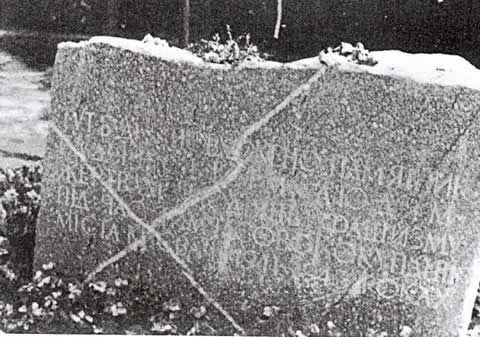 |
Monument
erected in 1966 at Babi Yar. The Ukrainian text reads: "On this site
there will be a monument for the victims of fascism (during the German
occupation of Kiev, 1941 - 1943."
|
Babi Yar Revolt
Starting August 18th 1943, the Germans headed by Blobel erased traces by removing the corpses and burnt them in furnaces made of the tombstones of the nearby Jewish cemetery. For 6 weeks a group of chained prisoners, Jews and Soviet prisoners of war, doomed to death as well, was forced to perform the operation.
From Martin Gilbert's
book "Holocaust":
... As the historian Reuben Ainsztein has written,
'in those half-naked men who reeked of putrefying flesh, whose bodies were eaten
by scabies and covered with a layer of mud and soot, and of whose physical strength
so little remained, there survived a spirit that defied everything that the
Nazis' New Order had done or could do to them. In the men whom the SS men saw
only as walking corpses, there matured a determination that at least one of
them must survive to tell the world about what happened in Babi Yar'.
29 September 1943 - 2 years after the massacre, the 325 forced-laborers in Babi Yar revolt and break out. 311 were shot down as they run. Only 14 survived. Among them were:
Fyodor Zavertanny
(escaped before)
Vladimir Davydov
Jacob Kaper
Filip Vilkis
Leonid Kharash,
I. Brodskiy
Leonid Kadomskiy
David Budnik
Fyodor Yarshov
Jakov Steiuk
Ostrovsky
Senya Berland
Volodya Kotlyar
Memorial to Babi Yar in U.S.A.
Alan G. Gass, FAIA, President of the Babi Yar Park Foundation:
We built a memorial park to the Babi Yar massacre in Denver, CO. It was dedicated in 1982, with an inscribed black granite entrance gateway, a "People Place" amphitheatre, a "Forest that Remembers" with a spring flowing all year in the middle, and a high-walled, narrow black bridge over a ravine, all at three points of a Mogen David carved out of the native pairie grasses. It is owned and maintained by the City & County of Denver. The park is used by the recently arrived immigrants from Russia and the former Soviet Union as a place of remembrance during the year and with a special ceremony on 29 September each year.